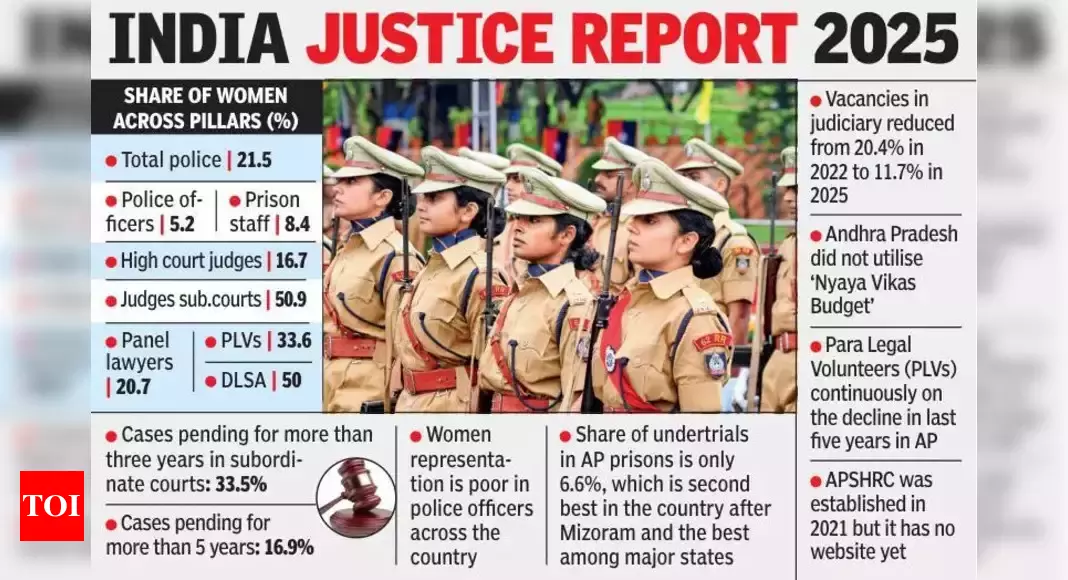India Justice Report 2025 | 19 Apr 2025
Why in News?
The India Justice Report (IJR) 2025 has been released, presenting a comprehensive assessment of the capacity and performance of Indian states in delivering justice.
What is the India Justice Report (IJR)?
- About: The India Justice Report is a first of its kind national periodic reporting that ranks the capacity of states to deliver justice.
- Parameter: It assesses 4 pillars: Police, Prisons, Judiciary, Legal Aid & SHRCs, using 5 parameters: human resources, infrastructure, budgets, workload, and diversity.
- Categorization of States: States are categorized as large/mid-sized (>1 crore population) and small (<1 crore) for fair comparison.
What are the Key Findings of the India Justice Report 2025?
- Overall Rankings: Karnataka, Andhra Pradesh, and Telangana top the large & mid-sized states, while Sikkim leads among small states. Bihar, Chhattisgarh, and Odisha show the most improvement.
- Share of Women in Police: Women continue to hold just 8% of officer posts and under 1,000 of 4,940 senior IPS roles, 90% serve in constabulary. However, 78% of police stations now have Women Help Desks.
- Gaps in Justice Delivery: There are around 21,000 judges (15 per million vs. recommended 50 by Law Commission), and high vacancies in HCs (33%) and district courts (21%).
- Per capita spend is just Rs 6 on legal aid and overall spending on the judiciary is Rs 182 per person per year, with no state allocating over 1% of its budget on the judiciary.
- The number of Paralegal Volunteers (PLVs) has dropped by 38% over 5 years, with only 3 PLVs per lakh population.
- PLVs, trained under the Legal Services Authorities Act, 1987, provide basic legal aid and awareness, especially in rural and marginalized areas.
- Police: India’s police force faces major manpower gaps, 28% officer shortfall and low presence (120 per lakh vs. global norm of 222), with one cop for every 831 people.
- Yet, it gets the highest per capita spending (Rs 1,275) among 4 justice pillars.
- Prisons: India’s prisons overcrowded with 131% occupancy and critical staff shortages- 28% in officers, 44% in correctional staff, and 43% in medical staff.
- The doctor-inmate ratio is 1:775 (norm: 1:300), with projections showing inmates may exceed capacity by 1.65 lakh by 2030.
- Under-trials make up 76% of prisoners, with many spending 3–5 years in custody.
- Caste-based segregation persists in prisons despite the SC striking down casteist provisions in 2024. Rehabilitation goals remain unmet, with only 6% of inmates receiving education and 2% vocational training in 2022.
What are the Key Issues Associated with Policing & Judiciary in India?Click Here to Read: Issues Associated with Policing in India, Issues Related to Indian Judiciary |
What are the Key Recent Initiatives Related to Judicial Reforms in India?Click Here to Read: Initiatives Related to Judicial Reforms |
Conclusion
The India Justice Report 2025 underscores India's aspirations and challenges in ensuring accessible, efficient, and inclusive justice. Despite the implementation of digital tools and reforms, fundamental capacity gaps persist. A comprehensive, sustained, and accountable approach is crucial to transforming justice delivery across the country.
|
Drishti Mains Question: India’s policing and judiciary systems are often criticized for delays and inefficiencies. Analyze the primary challenges faced by them and suggest steps to ensure timely and equitable justice. |
UPSC Civil Services Examination Previous Year Question (PYQ)
Prelims:
Q. With reference to the Indian judiciary, consider the following statements:
- Any retired judge of the Supreme Court of India can be called back to sit and act as a Supreme Court judge by the Chief Justice of India with the prior permission of the President of India.
- A High Court in India has the power to review its own judgement as the Supreme Court does.
Which of the statements given above is/are correct? (2021)
(a) 1 only
(b) 2 only
(c) Both 1 and 2
(d) Neither I nor 2
Ans: (c)
Mains:
Q. Discuss the desirability of greater representation to women in the higher judiciary to ensure diversity, equity and inclusiveness. (2021)
Q. Critically examine the Supreme Court’s judgement on ‘National Judicial Appointments Commission Act, 2014’ with reference to appointment of judges of higher judiciary in India. (2017)

